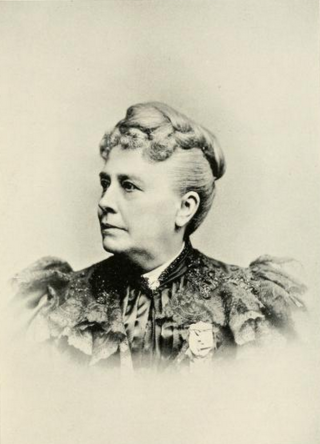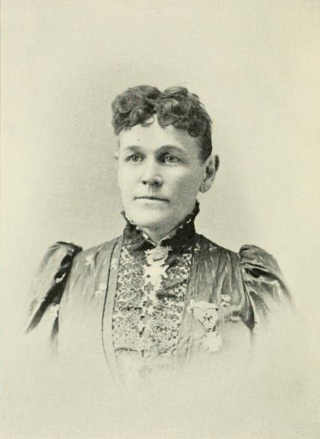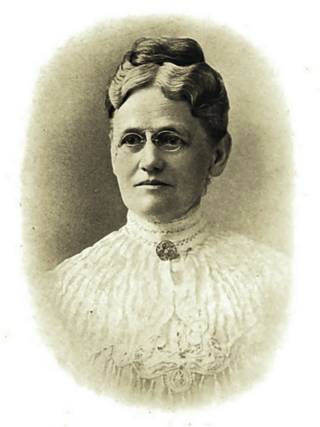
The Fort Des Moines Provisional Army Officer Training School was a military base and training facility on the south side of Des Moines, Iowa. Established in 1901, the base trained African American officers for the U.S. Army during World War I and was where women first began training for US Army service in 1942 as part of the Women's Army Corps. Surviving older portions of the base were declared a National Historic Landmark in 1974 in recognition of this history. The fort property was turned over to the city in the 1950s, and has since been put a number of public and private uses.

The T.G. Richards and Company Store, also known as Whatcom County Territorial Courthouse, is the first and oldest brick building in the state of Washington, United States, and is listed on the U.S. National Register of Historic Places.

The Franklin County G. A. R. Soldiers' Memorial Hall, also known simply as the Soldiers' Memorial Hall, is a historic building located in Hampton, Iowa, United States. The octagonal-style structure was designed and built in 1890 by Edward Carl Keifer. It was the meeting place of the J.W. McKenzie Post No. 81, Grand Army of the Republic (G.A.R.), which was one of 519 GAR posts in Iowa. The building is architecturally significant as it is one of the few examples of a Gothic Revival style structure of this type in the area. It is a memorial chapel that follows a cross-shaped plan capped by an octagonal cupola with a statue of a Union soldier on top. Its significance is also derived from it being the first G.A.R. Memorial Hall built in Iowa. The Iowa legislature had passed a law in 1884 that allowed counties to levy a tax to support building G.A.R. memorials. Captain Rufus S. Benson, a local state representative, had the law amended in 1886 so that it allowed for the construction of a memorial hall, as the local G.A.R. chapter wanted it to be a place where they could meet.

Annie Turner Wittenmyer was an American charitable organization leader, known for social reform, relief work, and her writing. She served as the first National President of the Woman's Christian Temperance Union (WCTU), seventh National President of the Woman's Relief Corps (WRC), and also served as president of the Non-Partisan National Woman's Christian Temperance Union. In 2007, Wittenmyer was inducted into the Iowa Women's Hall of Fame.

The Woman's Relief Corps (WRC) is a charitable organization in the United States, originally founded as the official women's auxiliary to the Grand Army of the Republic (GAR) in 1883. The organization was designed to assist the GAR and provide post-war relief to Union veterans. The GAR had been created as a "fraternal" organization and refused to allow women to join up until the creation of this auxiliary. It is largely dedicated to historical preservation of research and official documentation related to the WRC and GAR.

The Czecho Slovakian Association Hall, also known as Preucil School of Music, is a building in Iowa City, Iowa that was built in 1900, as a community center and meeting place for the Czechoslovakian Protective Society (C.S.P.S.), which later became the Czecho Slovakian Association. The C.S.P.S., like other fraternal organizations, began by offering a kind of insurance. The local chapter was organized in Iowa City in 1882. It served the Czech community that was concentrated in the north and northeast areas of the city. Like other C.S.P.S. halls, it hosted social, cultural, and educational activities, and this one also hosted gymnastics.

The W.R.C. Hall is a historic building located in Iowa Falls, Iowa, United States. Built in 1898, the building has segmented arched windows and a bracketed metal cornice, which are features of the Italianate style.

The Stephenson Grand Army of the Republic Memorial, also known as Dr. Benjamin F. Stephenson, is a public artwork in Washington, D.C. honoring Dr. Benjamin F. Stephenson, founder of the Grand Army of the Republic, a fraternal organization for Union veterans. The memorial is sited at Indiana Plaza, located at the intersection of 7th Street, Indiana Avenue, and Pennsylvania Avenue NW in the Penn Quarter neighborhood. The bronze figures were sculpted by J. Massey Rhind, a prominent 20th-century artist. Attendees at the 1909 dedication ceremony included President William Howard Taft, Senator William Warner, and hundreds of Union veterans.

The Boscobel Grand Army of the Republic Hall is located in Boscobel, Wisconsin. It was added to the National Register of Historic Places in 2007. Additionally, it is listed on the Wisconsin State Register of Historic Places.

The Black Hawk County Soldiers Memorial Hall, also known as Veterans Memorial Hall, is a Classical Revival veterans hall located at 1915 Courbat Ct. in downtown Waterloo, Black Hawk County, Iowa. It was built starting in June 1915 and first meeting was held there in December of the same year by the Grand Army of the Republic as a memorial to soldiers who died in the American Civil War. It was listed on the National Register of Historic Places in 1988 due to its architecture and importance in local history.

Sac City Monument Square Historic District is a nationally recognized historic district located in Sac City, Iowa, United States. It was listed on the National Register of Historic Places in 2015. The square consists of the General Sherman Hall (1892), Memorial Statue (1894), the American Legion Hall (1922), four World War II era Howitzers, and three granite tablets that commemorate the lives of the soldiers from Sac County who fought in World War I, World War II, the Korean War, and the Vietnam War. The Vietnam War tablet does not contribute to the historic district because it is a more recent installation.
G.A.R. Memorial Hall, also known as the Algona Schoolhouse, is a historic building located in Algona, Iowa, United States. It was built as the city's first schoolhouse in 1867, and moved to this location in 1887. The two-story frame Italianate structure features a gable roof, bracketed eaves, and wood lap siding. It originally had a belfry in the center of the roof, but it was removed at some point. After the building was moved it was used by the James C. Taylor Post No. 165 of the Grand Army of the Republic (G.A.R.), which had been organized in 1883. During the G.A.R.'s ownership the first floor was used as a library from 1899 to 1904. Because of declining numbers, the local G.A.R. Post gave the building to Hagg Post No. 90 of the American Legion Post in 1919 who used it for their clubhouse until 1967. At that time the Kossuth County Historical Society acquired the building, and they use it for a museum. It was listed on the National Register of Historic Places in 2014.

The Washington Avenue Commercial Historic District is a nationally recognized historic district located in Iowa Falls, Iowa, United States. It was listed on the National Register of Historic Places in 2012. At the time of its nomination the district consisted of 59 resources, including 42 contributing buildings and 15 non-contributing buildings. The district takes in most of the city's central business district. The buildings here were generally used for retail and office purposes. An opera house and theater are also located here. Around the edges of the district are buildings that housed automobile dealerships. The buildings generally range from one to two stories, but a couple structures are three stories in height. Built between 1857 and 1960, the buildings are composed of masonry construction. The commercial Italianate and Classical Revival styles are dominant.

The G. L. Stocker Blacksmith Shop, in Gettysburg, South Dakota, was built in 1901. It was listed on the National Register of Historic Places in 1996.

Lizabeth A. Turner was an American charitable organization leader who served as twelfth National President of the Woman's Relief Corps (WRC). Turner was involved in the Andersonville prison work, being chair of the board of managers of the National Reservation at Andersonville. She was also a model financier, and her service as a treasurer of large charitable enterprises was in great demand.

Mary E. Elliot (1851–1942) was an American writer and lecturer. She was active within the Woman's Relief Corps (W.R.C.) where she served for 50 years as Secretary of the Department of Massachusetts, and was also the organization's National Press Correspondent, 1908. Elliot was a regular contributor to the military department of The Boston Globe. From 1867 to 1885, she was active in temperance work.

Sarah E. Fuller (1838–1913) was an American philanthropist and social leader. For many years, she was affiliated with the Woman's Relief Corps (WRC). She served as the first President of its Massachusetts Department (1879–1882), and third President of the National organization. Fuller had a record of 40 years' service for the soldiers of the Union Army, having enrolled herself as a worker in the United States Christian Commission during the early days of the Civil War.

Sarah D. Winans was an American charitable organization leader who served as the 21st National President of the Woman's Relief Corps (WRC). For 50 years, she served in the cause of patriotism and relief of Civil War soldiers, widows, and orphans.



















